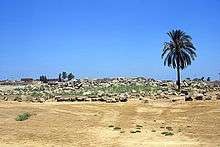Behbeit El Hagar

Behbeit El Hagar is an archaeological site in Lower Egypt. It contains an ancient Egyptian temple for the goddess Isis. The site lies along the Damietta branch of the Nile, north of Sebennytos and 8 kilometers (5 mi) west of Mansoura.[1] The temple is known as the Iseion, and was the first large temple to have been dedicated to Isis. In earlier shrines at the site, she may have been worshipped alongside her mythological husband, Osiris, and son, Horus. It was begun by the kings of the Thirtieth Dynasty (380–343 BC) and completed under Ptolemy III (r. 246–222 BC).[2]
The Iseion became one of Isis' major cult centers. It paralleled the deity's most important temple located at Philae in Upper Egypt. Unusually, the temple was built entirely of granite. It was demolished at some point, possibly in ancient times, by an earthquake or by the removal of its stone to serve as building material. Only scattered blocks remain there today.[1]
References
Further reading
- Favard-Meeks, Christine (1991). Le temple de Behbeit el-Hagara. Essai de reconstitution et d'interprétation. Buske Verlag.
- Favard-Meeks, Christine (2016). Behbeit el-Hagara web site
External links
![]() Media related to Behbeit El Hagar at Wikimedia Commons
Media related to Behbeit El Hagar at Wikimedia Commons
Coordinates: 31°01′40″N 31°17′15″E / 31.02778°N 31.28750°E